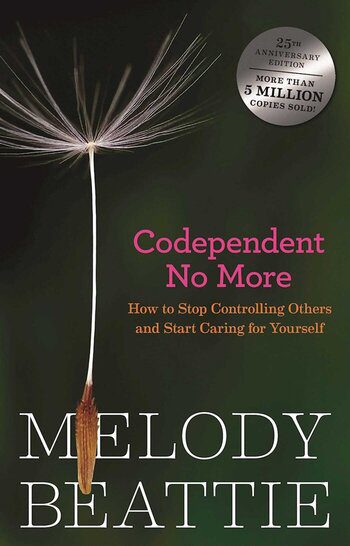“A codependent person is one who has let another person’s behavior affect him or her, and who is obsessed with controlling that person’s behavior.”
Author Melody Beattie has survived abandonment, kidnapping, sexual abuse, drug and alcohol addiction, divorce, and the death of a child. In Codependent No More: How to Stop Controlling Others and Start Caring for Yourself, Melody writes about codependent relationships. She shares life stories, personal reflections, exercises, self-tests, and strategies for dealing with codependency.
The surest way to make ourselves crazy is to get involved in other people’s business, and the quickest way to become sane and happy is to tend to our own affairs.
What’s Codependency?
In an article from the book Co-Dependency, An Emerging Issue, Robert Subby wrote codependency is “an emotional, psychological, and behavioral condition that develops as a result of an individual’s prolonged exposure to, and practice of, a set of oppressive rules—rules which prevent the open expression of feeling as well as the direct discussion of personal and interpersonal problems.”
“A codependent person is one who has let another person’s behavior affect him or her, and who is obsessed with controlling that person’s behavior.”
The other person might be a child, an adult, a lover, a spouse, a brother, a sister, a grandparent, a parent, a client, or a best friend. He or she could be an alcoholic, a drug addict, a mentally or physically ill person, a normal person who occasionally has sad feelings.
Codependents are Reactionaries.
They overreact. They under-react. But rarely do they act. They react to the problems, pains, lives, and behaviors of others. They react to their own problems, pains, and behaviors. Many codependent reactions are reactions to stress and uncertainty of living or growing up with alcoholism and other problems. It is normal to react to stress. It is not necessarily abnormal, but it is heroic and life-saving to learn how to not react and to act in more healthy ways. Most of us, however, need help to learn to do that.
Codependent Characteristics
CARETAKING
Codependents may: think and feel responsible for other people—for other people’s feelings, thoughts, actions, choices, wants, needs, well-being, lack of well-being, and ultimate destiny.
LOW SELF-WORTH
Codependents tend to: get angry, defensive, self-righteous, and indignant when others blame and criticize the codependents—something codependents regularly do to themselves.
REPRESSION
Many codependents: push their thoughts and feelings out of their awareness because of fear and guilt.
OBSESSION
Codependents tend to: feel terribly anxious about problems and people.
CONTROLLING
Many codependents: become afraid to let other people be who they are and allow events to happen naturally.
DENIAL
Codependents tend to: ignore problems or pretend they aren’t happening.
An estimated 80 million people are chemically dependent or in a relationship with someone who is.
Detachment
Most codependents are attached to the people and problems in their environments. Attachment is becoming overly-involved, sometimes hopelessly entangled.
Attachment can take several forms:
We may become excessively worried about, and preoccupied with, a problem or person (our mental energy is attached).
Or, we may graduate to becoming obsessed with and controlling of the people and problems in our environment (our mental, physical, and emotional energy is directed at the object of our obsession).
We may become reactionaries, instead of acting authentically of our own volition (our mental, emotional, and physical energy is attached).
We may become emotionally dependent on the people around us (now we’re really attached).
We may become caretakers (rescuers, enablers) to the people around us (firmly attaching ourselves to their need for us).
Worrying and obsessing keep us so tangled in our heads we can’t solve our problems. Whenever we become attached in these ways to someone or something, we become detached from ourselves. We lose touch with ourselves. We forfeit our power and ability to think, feel, act, and take care of ourselves. We lose control.
If people have created some disasters for themselves, we allow them to face their own proverbial music. We allow people to be who they are.
What is Detachment?
Detachment is releasing, or detaching from, a person or problem in love. We mentally, emotionally, and sometimes physically disengage ourselves from unhealthy (and frequently painful) entanglements with another person’s life and responsibilities, and from problems we cannot solve.
Detachment is based on the premises that each person is responsible for himself, that we can’t solve problems that aren’t ours to solve, and that worrying doesn’t help.
Detaching Lovingly
Detaching does not mean we don’t care. It means we learn to love, care, and be involved without going crazy. We stop creating all this chaos in our minds and environments. When we are not anxiously and compulsively thrashing about, we become able to make good decisions about how to love people, and how to solve our problems. We become free to care and to love in ways that help others and don’t hurt ourselves.
The rewards from detachment are great: serenity; a deep sense of peace; the ability to give and receive love in self-enhancing, energizing ways; and the freedom to find real solutions to our problems.
We cannot change people
We cannot change people. Any attempts to control them are a delusion as well as an illusion. People will either resist our efforts or redouble their efforts to prove we can’t control them. They may temporarily adapt to our demands, but the moment we turn our backs they will return to their natural state. Furthermore, people will punish us for making them do something they don’t want to do, or be something they don’t want to be.
The Karpman Drama Triangle
The Karpman drama triangle is a social model of human interaction proposed by Stephen B. Karpman. The triangle maps a type of destructive interaction that can occur among people in conflict.
Rescuing and Caretaking
We rescue people from their responsibilities. We take care of people’s responsibilities for them. Later we get mad at them for what we’ve done. Then we feel used and sorry for ourselves. That is the pattern, the triangle.
Caretaking doesn’t help; it causes problems. When we take care of people and do things we don’t want to do, we ignore personal needs, wants, and feelings. We put ourselves aside. Sometimes, we get so busy taking care of people that we put our entire lives on hold.
Rescuing leaves us bewildered and befuddled every time. It’s a self-destructive reaction, another way codependents attach themselves to people and become detached from themselves. It’s another way we attempt to control, but instead become controlled by people. Caretaking is an unhealthy parent-child relationship—sometimes between two consenting adults, sometimes between an adult and a child.
Caretaking breeds anger. Caretakers become angry parents, angry friends, angry lovers. We may become unsatisfied, frustrated, and confused Christians. The people we help either are or they become helpless, angry victims. Caretakers become victims.
Undependence
“Undependence” is a term Penelope Russianoff uses in her book to describe that desirable balance wherein we acknowledge and meet our healthy, natural needs for people and love, yet we don’t become overly or harmfully dependent on them.
“Knowing we can live without someone does not mean we have to live without that person, but it may free us to love and live in ways that work.”
Self Care
Self-care is an attitude toward ourselves and our lives that says, I am responsible for myself. I am responsible for leading or not living my life. I am responsible for tending to my spiritual, emotional, physical, and financial well-being. Self-care is an attitude of mutual respect. It means learning to live our lives responsibly. It means allowing others to live their lives as they choose, as long as they don’t interfere with our decisions to live as we choose.
THE FROG SYNDROME
There is an anecdote circulating through codependency groups. It goes like this: “Did you hear about the woman who kissed a frog? She was hoping it would turn into a prince. It didn’t. She turned into a frog, too.
Many codependents like to kiss frogs. We see so much good in them. Some of us even become chronically attracted to frogs after kissing enough of them. Alcoholics and people with other compulsive disorders are attractive people. They radiate power, energy, and charm. They promise the world. Never mind that they deliver pain, suffering, and anguish. The words they say sound so good.
If we don’t deal with our codependent characteristics, probabilities dictate we will continue to be attracted to and kiss frogs. Even if we deal with our characteristics, we may still lean toward frogs, but we can learn not to jump into the pond with them.
All the Best in your quest to get Better. Don’t Settle: Live with Passion.



7 Comments
Pingback: The Karpman Drama Triangle. – Lanre Dahunsi
Pingback: 100 Books Reading Challenge 2021 – Lanre Dahunsi
Pingback: Top Quotes on Codependency. – Lanre Dahunsi
Pingback: Book Summary -The New Codependency by Melody Beattie. – Lanre Dahunsi
Pingback: On Codependency. – Lanre Dahunsi
Pingback: Melody Beattie on Co-Dependency – Lanre Dahunsi
Pingback: Book Summary – Beyond Codependency by Melody Beattie. – Lanre Dahunsi